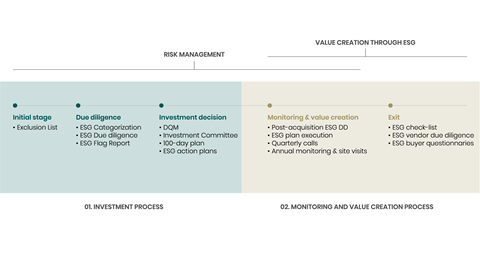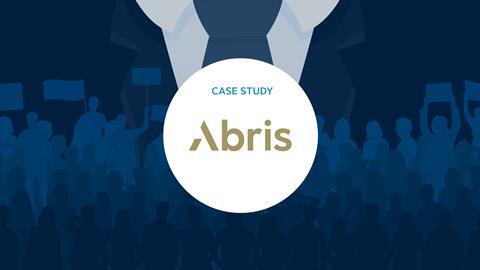Abris Capital Partners
- Signatory type: Investment manager
- Asset class: Private equity
- Operating region: Central Europe
For Abris Capital Partners, there is no longer any distinction between investing and responsible investing. ESG factors are present throughout the investment process.
Thanks to innovative tools we developed and a proprietary methodology, we can plan, monitor and measure the ESG impact on the businesses we invest in.
Why we incorporate human rights into the investment lifecycle
Firstly, we believe it is our fundamental ethical obligation. There is no credibility in our responsible investment approach if the fund fails to do its best to prevent any human rights violations. Secondly, from a business perspective, addressing human rights means managing reputational and legal risks. It means ensuring that we act in accordance with the law, in particular with labour law and international conventions.
Meanwhile, concern for human rights ensures that not only the company develops a committed workforce that operates in safe conditions, but so do its suppliers. Such a team achieves greater efficiency, ensures the quality of products and services, and reduces the risk of losses resulting, for example, from accidents or strikes.
Additionally, addressing human rights provides the building blocks for all other ESG activities. Taking care of human rights in the supply chain is an integral part of building a base of credible and reliable suppliers. There is also an unquestionable link between respecting human rights and mitigating the risk of corruption, primarily relating to contact with state administration officials and regulators.1
How we incorporate human rights into the investment lifecycle
Firstly, our responsible investment policy2 outlines our exclusion list, which states that we will refrain from investing in companies that do not respect human rights.
Secondly, Abris has become a Global Compact member and is committed to its 10 principles. We also engage in initiatives aimed at developing tools to help companies manage the risk of human rights violations. This included co-authoring the guide “Ethical and Social Standards are the Pathway for Small and Medium Enterprises to Collaborate with Large Clients”.3 We also joined a special working group appointed by the Polish Ministry of Funds and Regional Policy to prepare a practical guide and tools for the prevention of forced labour.
Thirdly, human rights are integrated into the investment process as Figure 1 outlines below. An integral element of the pre-acquisition due diligence process is the ESG stream, which includes analysing the risk of human rights violations. We have identified four main areas where there may be a risk:
- working and employment conditions;
- use of employment agencies that recruit temporary workers;
- the supply chain; and
- the use of new technologies, which is becoming more common.
For human rights risks in relation to employees of portfolio companies, Abris analyses issues such as: disciplinary rules; diversity and inclusion; anti-mobbing; discrimination; compulsory or child labour; fair wages; working conditions; and freedom of association.
Figure 1: Integration of ESG into the Abris investment lifecycle4

Post-investment, for each portfolio company the human rights risk level is further assessed and guides our actions. Three types of information are analysed:
1. risk exposure;
2. management practices; and
3. compliance requirements.
See the table below for sample questions on supply chains and cooperation with employment agencies.
| Area and Level of analysis | Supply chain | Employee outsourcing - cooperation with temporary employment agencies |
|---|---|---|
|
Risk exposure |
Do any of the company’s suppliers operate in a region with a high risk of human rights abuses? |
Does the company outsource any human resources processes? Does the company, in the agreement with employment agencies, have clauses preventing the violation of employee rights? |
|
Management practices and tools |
Does the company ensure compliance with human rights prior to agreeing supplier contracts? Does the company have a mechanism for communicating to customers and suppliers any human rights issues linked to the company’s products and services? Is the company aware of the exact sourcing locations for its key product components? Has the company identified high risk areas within its supply chain? Does the company screen and monitor all major suppliers, contractors, sub-suppliers and other major business associates for their commitment to human rights? Does the company have a Code of Conduct for suppliers? Does the company have a properly documented policy and clear procedures for the prevention of human rights abuses? |
Does the company prevent forced labour in employment agencies? Does the company monitor compliance with local labour laws related to foreign contractors? Does the company ensure that all workers have social insurance in accordance with local legal requirements? Do the workers have at least one day off for every six consecutive working days? Does the company prohibit the withholding of employees’ identification documents, by either the company or employment agencies acting on its behalf, both before and after employment begins? Do union representatives have access to members at the workplace? Does the company have procedures for age verification of employees at the time of recruitment? Does the company provide all workers with a written contract, in a language the employee understands, setting out the terms of employment? |
|
Legal issues |
Were there any legal disputes involving human rights abuses in last 12 months? |
Has the company been accused of using or benefiting from forced, compulsory or child labour in the last 12 months? Has the company been accused of maintaining a hostile working environment in the last 12 months? Is overtime aligned with labour regulations?
|
|
Indicators |
Does the company conduct employee trainings on human rights issues? Percentage of agreements with clauses regarding human rights or signed Code of Conduct for suppliers. |
Percentage of employees employed through outsourcing. Number of employees employed through outsourcing. Percentage of employees belonging to trade unions. |
After the analysis is complete, an action plan is prepared, and its effectiveness is measured with KPIs. Abris re-analyses these human rights risks on an annual basis, using our ESG Scoring Application – a tool developed for ESG risk management and building portfolio companies’ value.
We also push for the implementation of human rights-related practices within our portfolio. Each portfolio company is obliged to include a human rights clause in contracts with business partners. Companies using employment agencies are required to implement an effective human rights management system, including, for example, visits to employee accommodation. In addition, companies with suppliers located in countries with an increased risk of human rights violations must implement monitoring processes. We ensure our portfolio companies have appropriate certificates such as SA8000 or require independent audits following standards such as BSCI or SMETA.
Example: Building human rights protections in an apparel company
We identified during pre-acquisition due diligence that a company had a supply chain in countries with an increased risk of human rights violations. Therefore, the company was obliged to implement and effectively monitor the human rights risk management system. The following elements were implemented: a code of conduct for suppliers; a human rights policy, which specified that the company would only cooperate with suppliers with reliable certificates such as SA8000 and BSCI and/or positive results of SMETA audits;5 relevant clauses in contracts with suppliers; and audits of suppliers in terms of human rights compliance.
The company also employed workers through an employment agency. Therefore, it has introduced policies and actions to check human rights monitoring and eliminate potential cases of slave labour.
A whistleblowing system6 operated by an independent supplier was made available to all employees. The system allows for anonymous and safe reporting of abuse and non-compliance.
References
1https://www.ohchr.org/EN/Issues/Development/GoodGovernance/Pages/Corruption.aspx
2https://abris-capital.com/wp-content/uploads/2020/08/Abris-Capital-Partners_Responsible-Investment-Policy-August-2020.pdf
3https://www.abris-capital.com/wp-content/uploads/2020/09/Ethical-and-social-standards.pdf
4https://abris-capital.com/wp-content/uploads/2020/08/Abris-Capital-Partners_Responsible-Investment-Policy-August-2020.pdf
5https://www.sedex.com/our-services/smeta-audit/
6Whistleblowing: How and Why to Engage With Your Investee Companies – PRI guidanc e












